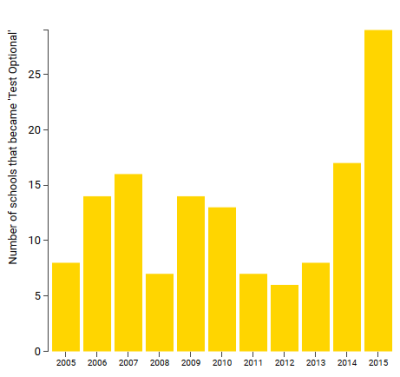
For many years, the SAT and ACT have been a staple of many high school students’ college applications, accepted by a majority of schools as proof of classroom capabilities. However, data shows that the number of colleges requiring standardized testing from all students is steadily dropping. Source: National Center for Fair & Open Testing. (Chart by Madeleine Deason)
WASHINGTON (Oct. 28, 2015)—October to March is a chaotic time when some students frantically cram vocabulary words from note cards and others skip the studying and hope for the best.
But as we enter the SAT-taking season, a trend is emerging.
Since the mid-1900s, the SAT and ACT have been staples for many high school students’ college applications and two of the exams most accepted by a majority of schools as proof of classroom capabilities. However, data shows that the number of colleges requiring standardized testing from students is steadily dropping.
The recent increase in colleges and universities across the country that no longer require applicants to submit their standardized test records, including SAT and ACT scores, indicates that institutes of higher education may no longer place as much value on a set of numbers from one day in which students are trapped in a crowded room for hours at a time.
From the fall of 2005 through the summer of 2006, nine schools de-emphasized the importance of the SAT and ACT, meaning they no longer required those scores from students who excelled in other areas like grades, according to FairTest, the National Center for Fair and Open Testing. From the fall of 2014 through last summer, 31 schools de-emphasized SAT and ACT use.
The turnaround has been gradual but striking.
In 2003, 82 percent of non-profit, traditional bachelor’s degree-granting, four-year colleges required or recommended a college entrance exam, according to Cyndie Schmeiser, the College Board’s chief of assessment. By 2013, that number had dropped to 78 percent. This number doesn’t reflect all universities, but it does reflect a good portion of them.
College Board is the organization that prepares and administers the SAT and other tests used in college admission and placement.
“Overwhelming evidence shows that SAT scores and high school GPA are the best predictors of college success,” Schmeiser said in an email.
However, a study conducted last year by William C. Hiss with the National Association for College Admissions Counseling found that “there are no significant differences in either Cumulative GPA or (college) graduation rates between submitters and non-submitters.”
“With almost 123,000 students at 33 widely differing institutions, the differences between submitters and non-submitters are five one-hundredths of a GPA point, and six-tenths of one percent in graduation rates,” the study concluded. “By any standard, these are trivial differences.”
Colleges and universities seem to agree with the study results, because almost 850 four-year higher education institutions are now at least partially test-optional, according to a database offered by FairTest.
On that list are local schools such as McDaniel College, Salisbury University and the University of Maryland University College, among others. Even schools as prestigious as New York University are taking part in the move away from the SAT.
Under test-optional policies, students who feel their scores are a good representation of themselves as students can choose to send their scores to colleges during the application process. Otherwise, depending on the specific college’s requirements, students can opt to keep schools from seeing their scores.
Most of these schools are still partially test-optional, meaning applicants must meet certain criteria to opt out of sharing scores. The criteria differs by school, but generally includes a requirement of a certain rank in a graduating class or a specific GPA. The alternative is fully test-optional, meaning that a school does not require these scores from any applicant should they choose to hold them back.
Some schools, like New York University, have other requirements. Students can hold their SAT scores back, but they are required to submit other scores to be considered for admission. For instance, three AP exam or SAT subject test scores in certain categories can be turned in rather than an SAT or ACT score. An International Baccalaureate diploma or scores from three higher-level IB exams also count.
This year marked the lowest SAT scores since 2005, the last time the exam was revamped. In 2005, the writing portion was added to the SAT but after this January’s exams, the writing section will be optional. In March 2016, the SAT will undergo several major changes, including an optional essay portion and no penalty for guessing answers, among other changes.
McDaniel College in Westminster, Md., was the first college in the state to opt for a test-optional policy in the early 2000s. The school isn’t entirely test-optional: the only students exempt from sending SAT or ACT scores must be in the top 10 percent of their class or, if they go to high schools that don’t rank, have a GPA of 3.5 or better on a 4.0 scale.
The college decided to change its policy because sometimes students do well in high school but not as well on the exam, said Florence Hines, McDaniel’s dean of admissions.
“When the test scores might not be particularly impressive, it enables us to look at the whole person rather than simply use numbers,” she said.
GPA and course rigor are more accurate indicators of success in college because they’re measured over four years, Hines said, whereas an SAT score takes place in one or several sittings.
“If you’re a high-achieving student, we’ll see that in different ways than just test scores,” she said.
Over time, the school’s average SAT scores have remained “remarkably the same,” Hines said.
What did change, she said, was the number of applicants the school receives annually. Since the new testing policy was implemented, the number of applicants has continued to increase.


